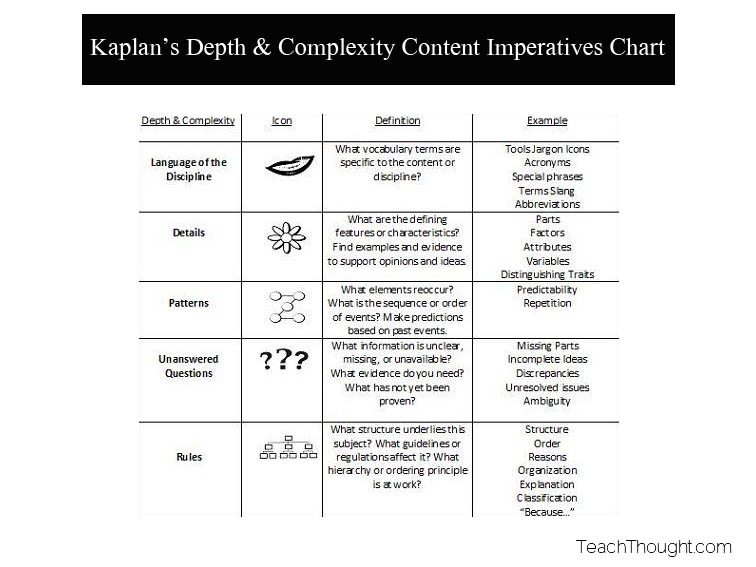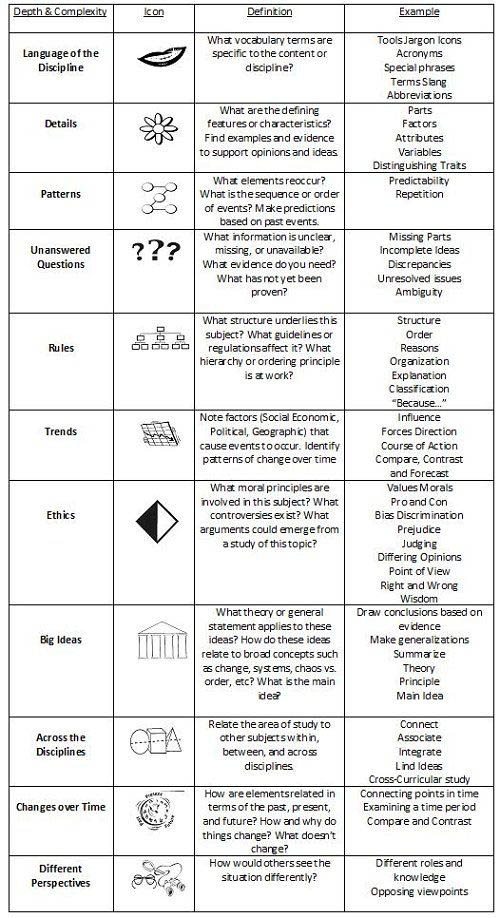
What Is Kaplan’s Depth And Complexity Chart?
by TeachThought Staff
Framing content is among the most powerful strategies teachers have to engage students and promote a deeper understanding of content.
One example is project-based learning, which is both an instructional design tool for teachers, as well as a (potentially) engaging ways for learners to approach content. This stands in contrast to other learning trends–self-directed learning, for example–that don’t frame or ‘suggest’ content pathways at all, but rather describe another characteristic–who ‘directs’ the learning, for example.
The Common Core standards, on the other hand, do in fact suggest content. In fact, they state explicitly exactly what a student is to learn. In that way, they take a frame content area–Math, for example–and says “Students ‘learning’ math should learn this, this, and this.” The advantage here is that it takes the guesswork out of who’s learning what.
See also 8 Ways Parents Can Support Critical Thinking At Home
The downside? Though the Common Core Standards are thought of as more complex compared to state standards in many areas of the United States, to say that they are the only–or even the best–ways to frame content areas and promote complex and critical inquiry of important academic literacies is not true.
This is where the following chart from Dr. Sandra Kaplan comes in.
11 Ways To Use Kaplan’s Depth And Complexities Chart
This complexities chart is somewhat reminiscent of 27 Actions That Promote Self-Directed Learning, where we focused strictly on the ‘cognitive action,’ and made the academic standard or content secondary.
Take the idea of ‘theme’ in English-Language Arts, framed by any of the following areas.
1. Language of the Discipline:
What academic and non-academic language is used to discuss, explore, or understand theme both in the classroom and the real world?
2. Details:
What are the ‘parts’ of theme? What is its definition? How is its meaning related to the meaning of tangent academic language?
3. Patterns:
What sort of patterns emerge through investigations of literary themes, within texts, digital media, or the discussion of those texts and digital media in an academic setting?
4. Unanswered Questions:
What questions are still unanswered or beyond the ‘reach’ of theme? Does it seem like there may eventually be progress there? What would have to happen for that progress to occur?
5. Rules:
What are the rules for using, analyzing, and applying themes?
6. Trends:
What cultural trends exist in regards to thematic patterns over the last 250 years? Or 250 days on the internet–memes, for example?
7. Ethics:
How do themes inform ethics–and vice-versa?
8. Big Ideas:
What are the big ideas in this content ‘niche’ that resurface over and over again? And what is your hunch why that might be?
9. Across the Disciplines:
How does the study of theme in ELA relate to Push/Pull factors in immigration, war, or the scientific process?
10. Changes Over Time:
How has our use–and understanding of–theme changed over time? Has it gotten more or less complex? How has music changed how we understand theme?
11. Different Perspectives:
How do competing analyses of theme serve a deeper understanding of text or digital media?
Lovely, right? Whether you want to use it for unit essential questions, to guide Socratic discussions, create writing prompts, or frame lessons and assessments, this is an interesting way to consistently promote complex and in-depth analysis of academic and non-academic content.
Would love to hear how you might use it in your classroom in the comments below.

Note: Note that this isn’t an either/or proposition. You can use the Common Core Standards and a chart like this. In that case, you’d take a standard–or concept behind a standard–and “refract” it through whichever of the following Depth or Complexity made the most sense according to that student’s knowledge level.
11 Ways To Frame Content: A Depth, Complexity & Content Imperatives Chart
